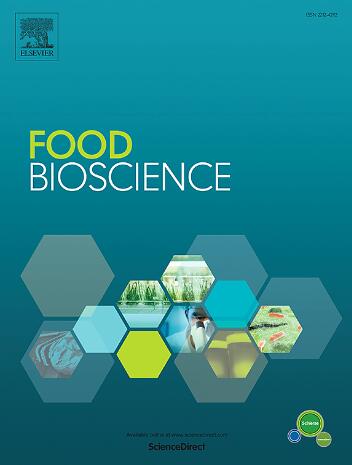Unlocking bioinformatics and structural insights of a novel thermo-alkaline pectate lyase ScpB from Phytophthora parasitica INRA-310
IF 5.9
1区 农林科学
Q1 FOOD SCIENCE & TECHNOLOGY
引用次数: 0
Abstract
Pectate lyase (PEL) has broad industrial utility, but its application is limited by insufficient thermal stability and alkali tolerance. In this study, a novel PEL (hereafter, ScpB) from Phytophthora parasitica INRA-310 was identified for the first time through data-driven mining and bioinformatics. Homology modeling revealed that ScpB consists of two domains: a PEL superfamily-associated domain ScpB-I and a catalytic domain ScpB-II, which are connected by a short linker region. Based on truncated engineering and protein structure engineering strategies, ScpB-I and ScpB-II must cooperate to exhibit the PEL activity. Furthermore, ScpB was recruited for developing biochemical properties. The purified ScpB exhibited optimal activity at pH 10.0 and 55 °C, aligning with textile biorefining conditions. Notably, in the presence of Ca2+ and Fe3+, a 215.97 % and 182.08 %, respectively, improvement in catalytic activity compared to the control group without metal ion. Finally, the bioscouring assay was carried out, ScpB exhibited a significant increase in the wetted fabric area to 5.371 ± 0.382 cm2, which was 3.6 times that of the untreated sample (1.496 cm2). Scanning electron microscopy confirmed effective pectin removal and smoother fibers. This study expands the PEL resource library and offers a promising enzyme for efficient, eco-friendly textile biorefining.

从疫霉INRA-310中提取的新型热碱性果胶裂解酶ScpB的生物信息学和结构分析
果胶裂解酶(PEL)具有广泛的工业用途,但其热稳定性和耐碱性不足,限制了其应用。本研究利用数据驱动挖掘和生物信息学技术,首次从疫霉菌INRA-310中鉴定出一个新的PEL(以下简称ScpB)。同源性建模显示,ScpB由两个结构域组成:PEL超家族相关结构域ScpB- i和催化结构域ScpB- ii,它们通过短连接子区域连接。基于截断工程和蛋白结构工程策略,ScpB-I和ScpB-II必须协同发挥PEL活性。此外,ScpB被用于发展生化特性。纯化后的ScpB在pH 10.0和55℃条件下具有最佳活性,符合纺织生物精制条件。值得注意的是,在Ca2+和Fe3+的存在下,催化活性分别比不含金属离子的对照组提高了215.97%和182.08%。最后进行生物洗涤试验,ScpB在织物上的浸湿面积显著增加,达到5.371±0.382 cm2,是未处理样品(1.496 cm2)的3.6倍。扫描电子显微镜证实有效的果胶去除和更光滑的纤维。这项研究扩大了PEL资源库,并为高效、环保的纺织品生物精制提供了一种有前途的酶。
本文章由计算机程序翻译,如有差异,请以英文原文为准。
求助全文
约1分钟内获得全文
求助全文
来源期刊

Food Bioscience
Biochemistry, Genetics and Molecular Biology-Biochemistry
CiteScore
6.40
自引率
5.80%
发文量
671
审稿时长
27 days
期刊介绍:
Food Bioscience is a peer-reviewed journal that aims to provide a forum for recent developments in the field of bio-related food research. The journal focuses on both fundamental and applied research worldwide, with special attention to ethnic and cultural aspects of food bioresearch.
 求助内容:
求助内容: 应助结果提醒方式:
应助结果提醒方式:


